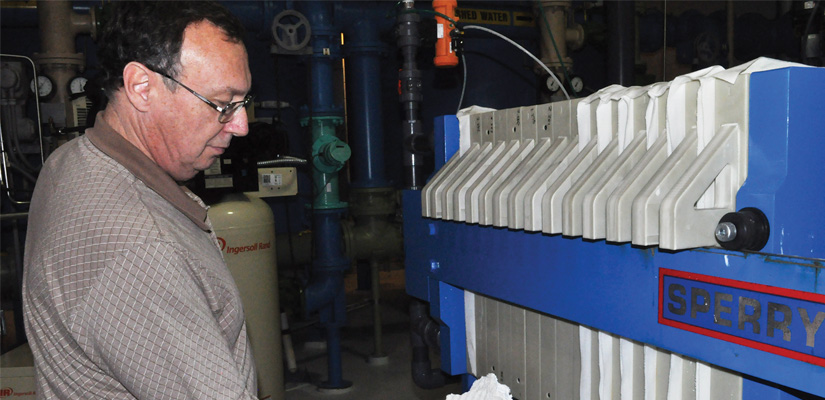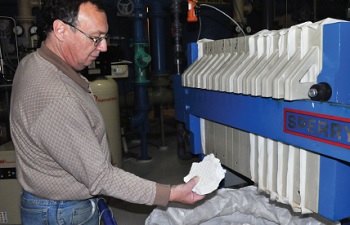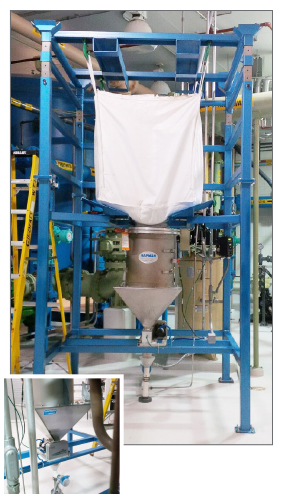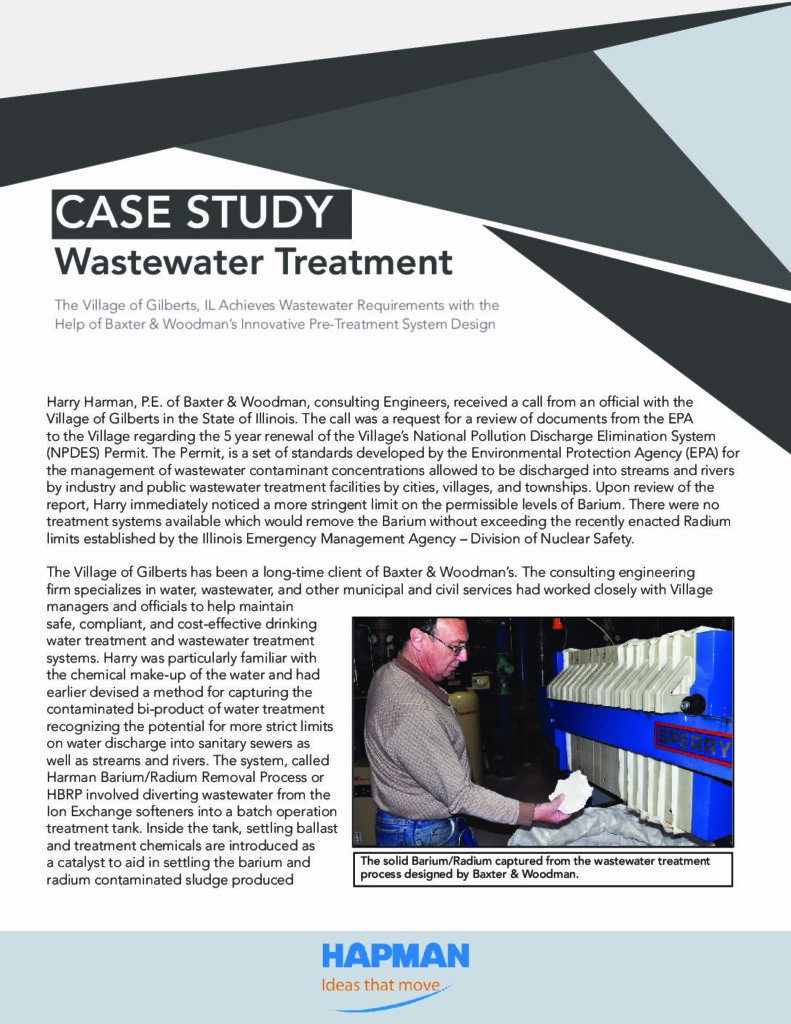
CHALLENGE
Harry Harman, P.E. of Baxter & Woodman, consulting Engineers, received a call from an official with the Village of Gilberts in the State of Illinois. The call was a request for a review of documents from the EPA to the Village regarding the 5 year renewal of the Village’s National Pollution Discharge Elimination System (NPDES) Permit. The Permit, is a set of standards developed by the Environmental Protection Agency (EPA) for the management of wastewater contaminant concentrations allowed to be discharged into streams and rivers by industry and public wastewater treatment facilities by cities, villages, and townships. Upon review of the report, Harry immediately noticed a more stringent limit on the permissible levels of Barium. There were no treatment systems available which would remove the Barium without exceeding the recently enacted Radium limits established by the Illinois Emergency Management Agency – Division of Nuclear Safety.
CUSTOMER
The Village of Gilberts
INDUSTRY
Wastewater Treatment
The Village of Gilberts, IL Achieves Wastewater Requirements with the Help of Baxter Woodman’s Innovative Pre-Treatment System Design
The Village of Gilberts has been a long-time client of Baxter & Woodman’s. The consulting engineering firm specializes in water, wastewater, and other municipal and civil services had worked closely with Village managers and officials to help maintain safe, compliant, and cost-effective drinking water treatment and wastewater treatment systems. Harry was particularly familiar with the chemical make-up of the water and had earlier devised a method for capturing the contaminated bi-product of water treatment recognizing the potential for more strict limits on water discharge into sanitary sewers as well as streams and rivers. The system, called  Harman Barium/Radium Removal Process or HBRP involved diverting wastewater from the Ion Exchange softeners into a batch operation treatment tank. Inside the tank, settling ballast and treatment chemicals are introduced as a catalyst to aid in settling the barium and radium contaminated sludge produced during the pre-treatment process. The ballast increased the weight of the material causing the solids to settle more quickly and efficiently inside the tank. The pre-treatment system operates in a batch type mode to coincide with the batch regeneration of the ion exchange softeners. Following the treatment cycle, the settled solids are sent through a filter for dewatering then to a municipal landfill for disposal.
Harman Barium/Radium Removal Process or HBRP involved diverting wastewater from the Ion Exchange softeners into a batch operation treatment tank. Inside the tank, settling ballast and treatment chemicals are introduced as a catalyst to aid in settling the barium and radium contaminated sludge produced during the pre-treatment process. The ballast increased the weight of the material causing the solids to settle more quickly and efficiently inside the tank. The pre-treatment system operates in a batch type mode to coincide with the batch regeneration of the ion exchange softeners. Following the treatment cycle, the settled solids are sent through a filter for dewatering then to a municipal landfill for disposal.
The patent-pending Barium Removal System would help the Village of Gilberts meet the new discharge requirements. Harry had the system design completed and proven, what he needed was help with finding the best equipment to make his ballast feed system work efficiently. Harry sought the assistance of Maggie Beauchamp, sales engineer with Gull Material Handling Company. Gull Material Handling is known throughout Illinois as the company to rely on for design and sourcing assistance related to process and bulk material handling equipment. When Harry explained the HBRP system design to Maggie and expressed his needs for an effective delivery system for the settling ballast, Maggie knew she would recommend a custom Bulk Bag Unloader from Hapman to achieve the needed results. The ballast, a sandlike material, is received in bulk bags, Hapman’s bulk bag unloader allows the 2500 lb bag to be easily hooked on a solid steel frame and positioned with a fork truck securely on the steel base frame. The Bulk Bag Unloader safely holds the bag in place and provides safe, clean dispersion of the ballast sand. The Hapman unloader was custom designed with a portal to access the bag spout for tie-off and an integral transfer hopper.
The hopper allows the ballast to discharge from the bag without flooding the feeder below. The feeder automatically meters the material at a rate of four cubic feet (400 pounds) per hour. The metered ballast enters a pneumatic conveying system that carries the material to the treatment tank.
 “The Bulk Bag Unloading System gave me the ability to control the settling process”, notes Harman, P.E. For this application, Harman approved the Hapman Bulk Bag Unloader and feeder system as a key element to the process equipment design. The ability to custom engineer the unloader to fit the exact bag dimensions while also maintaining a footprint that worked inside the Gilbert’s facility were important factors in the equipment selection process. In addition, the accuracy of the integral feeder assembly provided the critical material flow rate. The entire system has proven extremely successful for the Village of Gilberts. The Barium levels in the wastewater came down almost immediately from 6 mg/l to 0.6 mg/l. The low concentration level of the Barium was well within the new EPA guidelines and would allow the Village to discharge the wastewater safely, and without fines, into the Creek receiving the wastewater. In addition, the HBRP system captured the Radium reducing levels in the biosolids from 100 pCi/gram to 13pCi/gram so they could safely be used for fertilizer on local farm fields while the dewatered solids could be safely disposed at the local landfill.
“The Bulk Bag Unloading System gave me the ability to control the settling process”, notes Harman, P.E. For this application, Harman approved the Hapman Bulk Bag Unloader and feeder system as a key element to the process equipment design. The ability to custom engineer the unloader to fit the exact bag dimensions while also maintaining a footprint that worked inside the Gilbert’s facility were important factors in the equipment selection process. In addition, the accuracy of the integral feeder assembly provided the critical material flow rate. The entire system has proven extremely successful for the Village of Gilberts. The Barium levels in the wastewater came down almost immediately from 6 mg/l to 0.6 mg/l. The low concentration level of the Barium was well within the new EPA guidelines and would allow the Village to discharge the wastewater safely, and without fines, into the Creek receiving the wastewater. In addition, the HBRP system captured the Radium reducing levels in the biosolids from 100 pCi/gram to 13pCi/gram so they could safely be used for fertilizer on local farm fields while the dewatered solids could be safely disposed at the local landfill.
